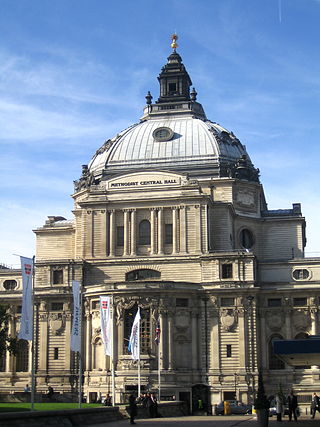
Methodism, also called the Methodist movement, is a group of historically related denominations of Protestant Christianity whose origins, doctrine and practice derive from the life and teachings of John Wesley. George Whitefield and John's brother Charles Wesley were also significant early leaders in the movement. They were named Methodists for "the methodical way in which they carried out their Christian faith". Methodism originated as a revival movement in the Church of England in the 18th century and became a separate denomination after Wesley's death. The movement spread throughout the British Empire, the United States, and beyond because of vigorous missionary work, and today has about 80 million adherents worldwide.
Alexander Kilham was an English Methodist minister.
The Primitive Methodist Church is a Methodist Christian denomination within the holiness movement. It began in England in the early 19th century, with the influence of American evangelist Lorenzo Dow (1777–1834).

Primitive Methodism was a major movement in English and Welsh Methodism from about 1810 until the Methodist Union in 1932. It emerged from a revival at Mow Cop in Staffordshire. Primitive meant "simple" or "relating to an original stage"; the Primitive Methodists saw themselves as practising a purer form of Christianity, closer to the earliest Methodists. Although the denomination did not bear the name "Wesleyan", Primitive Methodism was Wesleyan in theology, in contrast to the Calvinistic Methodists.

The Bible Christian Church was a Methodist denomination founded by William O’Bryan, a Wesleyan Methodist local preacher, on 18 October 1815 in North Cornwall. The first society, consisting of just 22 members, met at Lake Farm in Shebbear, Devon. Members of the Church were sometimes known as Bryanites, after their founder.

The Free Wesleyan Church of Tonga is a Methodist denomination in Tonga. It is the largest Christian denomination in the nation and is often mistaken to be its state church. It has its roots in the arrival of the first missionaries from the London Missionary Society and the ministry of the Wesleyan Methodist Mission Society, the latter of which cemented its Methodist identity.
United Methodist Free Churches, sometimes called Free Methodists, was an English nonconformist community in the last half of the 19th century. It was formed in 1857 by the amalgamation of the Wesleyan Association and the Wesleyan Reformers.

Jabez Bunting was an English Wesleyan Methodist leader and the most prominent Methodist after John Wesley's death in 1791.

The Methodist Church of Southern Africa (MCSA) is a large Wesleyan Methodist denomination, with local churches across South Africa, Namibia, Botswana, Lesotho and Eswatini, and a more limited presence in Mozambique. It is a member church of the World Methodist Council.
The Evangelical Church of North America (ECNA) is a Wesleyan-Holiness, Protestant Christian denomination headquartered in Clackamas, Oregon. As of 2000, the Church had 12,475 members in 133 local churches. The Church sponsors missionaries in seven countries.
English Wesleyan Mission was a British Methodist missionary society that was involved in sending workers to countries such as New Zealand in the 19th century and China during the late Qing Dynasty.
Jabez Bunting Waterhouse was an English-born Australian Methodist minister and a leading legislator within Methodist conferences.

The organisation of the Methodist Church of Great Britain is based on the principle of connexionalism. This means that British Methodism, from its inception under John Wesley (1703–1791), has always laid strong emphasis on mutual support, in terms of ministry, mission and finance, of one local congregation for another. No singular church community has ever been seen in isolation either from its immediately neighbouring church communities or from the centralised national organisation. Wesley himself journeyed around the country, preaching and establishing local worshipping communities, called "societies", often under lay leadership. Soon these local communities of worshipping Christians formalised their relationships with neighbouring Methodist communities to create "circuits", and the circuits and societies contained within them, were from the very beginning 'connected' to the centre and Methodism's governing body, the annual Conference. Today, societies are better known as local churches, although the concept of a community of worshipping Christians tied to a particular location, and subdivided into smaller cell groups called "classes", remains essentially based on Wesley's societies.
The Allegheny Wesleyan Methodist Connection (AWMC), originally the Wesleyan Methodist Church (Allegheny Conference), and also known as the Wesleyan Methodist Church (WMC), is a Methodist denomination within the conservative holiness movement primarily based in the United States, with missions in Peru, Ghana, and Haiti.
Thomas Allin (1784–1866) was an English ordained minister in the Methodist New Connexion, a breakaway denomination of the Methodist Church, which was established in Hanley, Stoke-on-Trent in 1797. Thomas Allin was born in Shropshire, England, on 10 February 1784. He died on 6 November 1866.

The history of Methodism in the United States dates back to the mid-18th century with the ministries of early Methodist preachers such as Laurence Coughlan and Robert Strawbridge. Following the American Revolution most of the Anglican clergy who had been in America came back to England. John Wesley, the founder of Methodism, sent Thomas Coke to America where he and Francis Asbury founded the Methodist Episcopal Church, which was to later establish itself as the largest denomination in America during the 19th century.

Henry Youngman (1848–1927) was a Methodist minister. He was President-General of the Methodist Church of Australasia and often described as the Father of Methodism in Queensland.
William Bramwell was an English Methodist itinerant preacher who led a successful Christian revival in Yorkshire.

Samuel Warren (1781–1862) was a Wesleyan Methodist minister, who formed a breakaway group of "Warrenites", and in later life was an Anglican priest.










